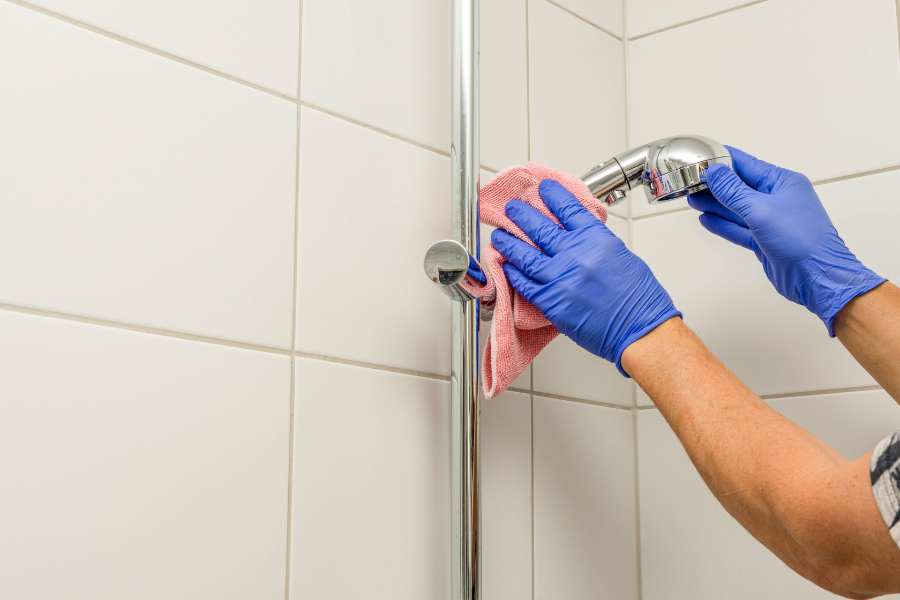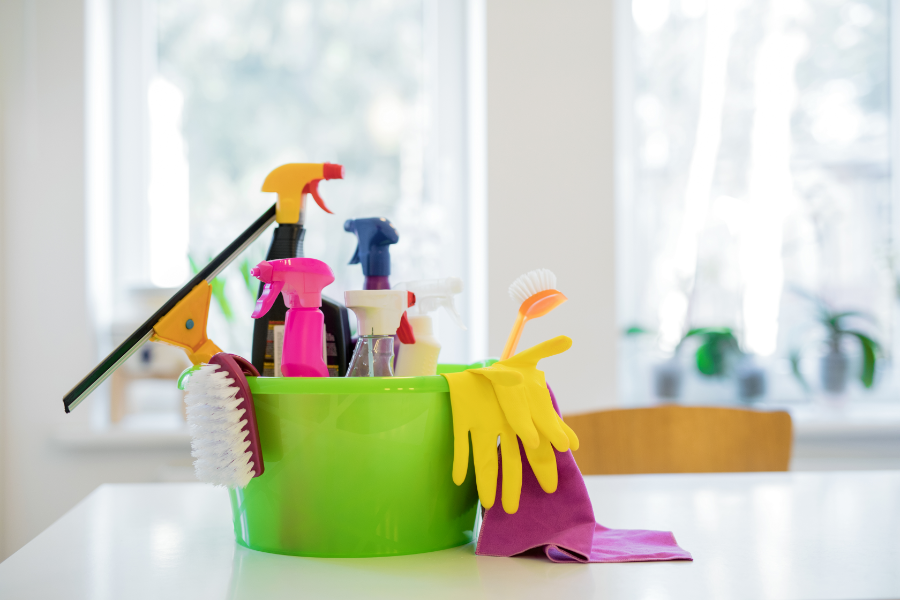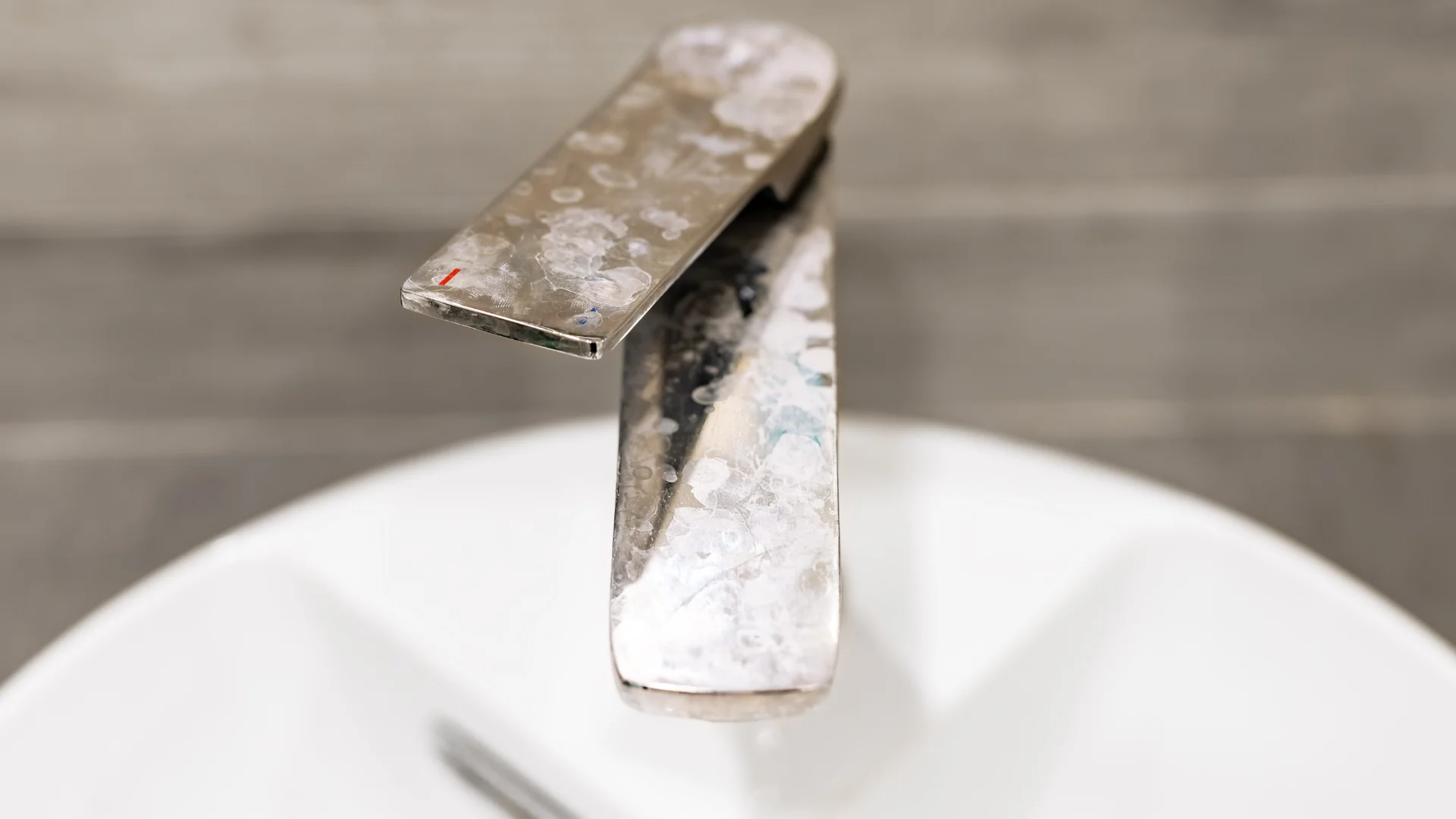Calcium deposits are unappealing stains that develop in many homes. These stains form through the water with calcium salts or hard water. When calcium deposits build up, it’s time to clean and remove them. But how do you clean and remove calcium deposits? Does vinegar clean calcium deposits?
Yes, vinegar does clean calcium deposits. Its acidic properties make it a great all-purpose, versatile home cleaner that is effective for cleaning up faucets, sinks, and fixtures stained with calcium deposits.
In this post, let’s find out how to remove calcium deposits in various parts of your home and some tips to prevent them.
What is a Calcium Deposit?
Calcium deposits are common in homes with hard water. They typically form in pipes and drains and when left unresolved, will cause blockages and corrosions.
Calcium deposits have an unsightly appearance, such as thick, chalky, and whitish deposits commonly found in and on taps, showerheads, and many appliances. They are harmless, but these scaly and scummy deposits are pretty nasty.
Is Vinegar Effective in Cleaning Calcium Deposits?
Vinegar is a safe, all-natural household cleaner. It has acidic content, which can remove calcium deposits.
Because of its acidic properties, vinegar removes stains and any organic matter, breaking it down and dissolving it.
What Types of Vinegar Clean Calcium Deposits
Many types of vinegar can clean away calcium deposits. However, white vinegar and apple cider vinegar are the most common and safest items to use at home.
If these two do not work well enough, you can use cleaning vinegar because it has more acidic properties.
How Often Should You Clean Calcium Deposits on Fixtures?

Daily cleaning will keep your appliances, sinks, and bathroom surfaces free from calcium deposits. However, clean fixtures like faucets, taps, or shower heads immediately after use.
If calcium deposits aren’t as much of a problem in your home, monthly cleaning is enough. The frequency of cleaning or removing calcium deposits is dependent on how much water you use.
How to Clean Calcium Deposits on Shower Heads and Faucets?
House fixtures like shower heads and other fixtures are typically the victims of calcium deposits.
To prevent the buildup, remove the stains as soon as possible. If you fail to do so, the calcium deposits could penetrate the surface of the fixtures and lead to corrosion.
Things you’ll need:
- Vinegar
- Water
- Clean cloth
Instructions:
- When cleaning fixtures, you can tie a bag of vinegar over the shower head or faucets, as it will help remove the exterior buildup.
- For deep cleaning, remove the showerhead from its base or the faucet aerator.
- Place the detached pieces in a bowl of diluted vinegar. Let it sit for an hour.
- Rinse the pieces with clean water and wipe them with a clean cloth.
How to Clean Calcium Deposits in Your Tubs, Sinks, Toilets, Porcelain, and Ceramic Tile
Your bathroom is a prime area for calcium deposits. It’s vital to be proactive in this area to avoid permanent stains or other damage.
Things you’ll need:
- Vinegar
- Baking soda
- Hot water
- Liquid soap
- Rag or sponge
- Clean towel
- Old toothbrush
Instructions:
- Mix hot water and a couple of drops of liquid soap.
- Put some of the resulting mixtures on a rag or sponge, then use it to clean the surface.
- Scrub the surfaces to wipe off stains, then wipe them with a dry clean towel.
- Create a paste by mixing vinegar and baking soda.
- Rub the paste into the affected area or calcium buildup. Leave it for about five minutes or until the mineral deposits soften.
- Remove the paste with a sponge or rinse it with water to finish.
How to Clean Calcium Deposits in Your Appliances?
When it comes to calcium deposit formation at home, don’t forget to check your small appliances.
Calcium deposits also form in appliances like kettles, coffee machines, and blenders as water is used and often left to dry in these areas.
Here’s how you can clean calcium deposits in these appliances.
Things you’ll need:
- Vinegar
- Water
- Clean towel
Instructions:
- Add equal portions of water and vinegar to the appliance (coffee maker, kettles, blender).
- Turn on the appliance as usual for about three minutes. Turn it off and leave the mixture for about an hour.
- Turn on the appliance once again.
- Empty the appliance and replace it with clean water to rinse everything.
- 5. Wipe the appliance with a clean towel to dry it.
What Other Household Items Can Clean Calcium Deposits?
If your once-bright glass shower or faucet is now stained and dingy, the best way to restore it to brand-new is to get rid of the hard water stains. Besides vinegar, here are some household staples you can use to resolve your calcium deposit problems:
Fluoride Toothpaste
Did you know you can use your regular toothpaste to remove calcium deposits? Toothpaste has active ingredients that are effective in removing hard water stains. This method is simple; you only need an old toothbrush and toothpaste.
Just add toothpaste to the toothbrush and use it to brush the affected area for about 1 minute. Leave the toothpaste for at least 5 to 10 minutes. Later, wash it off with a clean, dry towel.
Baking Soda
Baking soda can also remove calcium deposits or hard water stains. To do this, simply follow the method for fluoride toothpaste. Make a baking soda paste by mixing water and baking soda. Replace the toothpaste from the process above with baking soda.
Lemon Juice
Lemon juice is a natural ingredient that can prevent calcium deposit build-up. It can help prevent hard water stains from forming in the first place. To use lemon juice, you need to add a few tablespoons of it to a spray bottle and then apply the mixture to the affected area.
Expert Tips to Prevent Calcium Deposit Buildup

Calcium deposit buildup can be difficult to resolve. If you don’t want to deal with it in the future, you’re in luck as you can prevent its formation.
Use Vinegar Often
You can prevent calcium deposits by utilizing this effective household ingredient.
Most hard water is made from calcium, which is reactive with acids like vinegar. Please treat it with vinegar as soon as possible whenever you notice a buildup.
Minimize Your Water Temperature
You may not realize it yet, but running hot water through your water heater is an added factor of hard water stains and calcium deposit formations.
Reducing the temperature of your water heater will delay the accumulation of calcium deposits.
Clean Appliances and Pipes Immediately
It’s vital to treat calcium buildup on appliances immediately. This rule also applies to pipes as they are also vulnerable to calcium buildup.
Install a Water Softener
A water softener is a good investment for those who live in hard water areas. A water softener can remove magnesium, minerals, and calcium from your water supply, transforming the hard water into soft water.
Get Professional Help
If the calcium buildup on your faucets, fixtures, or sinks becomes overwhelming and you can’t get rid of it, you may need professional cleaners.
Also, if the buildup has occurred in your plumbing, contact a licensed plumber. Don’t hesitate to ask for help before things get worse and more expensive to repair.
Conclusion
Does Vinegar Clean Calcium Deposits? As you have read, it does.
However, take note that since calcium deposits are related to minerals and water, it may be hard to control them as a homeowner. As such, calcium deposits may form whether you like them or not.
What you can do, however, is to work on preventing the proliferation of calcium buildup, as it may further damage any surfaces or pipes in your house.
What you can do, however, is to work on preventing the proliferation of calcium buildup, as it may damage any surfaces or pipes in your house.
If you are unable to do that and calcium does build up in your home, use the methods mentioned above to clean and remove calcium buildup.
To learn what else you can use vinegar to clean in your home, read our article – Does Vinegar Clean Limescale?

